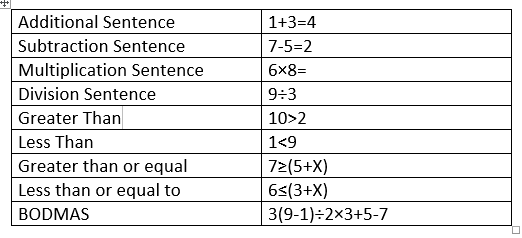What Is A Number Sentence? Get A Detailed Idea
A number sentence is a term used instead of the word "equation" in elementary mathematics. It is a mathematical sentence written in numerals and mathematical symbols.
It can be defined as a combination of numbers and mathematical operations that students are frequently asked to solve.
Number sentences are important in mathematics because they express connections and processes between numerical quantities. These sentences define a specific equation or inequality using numbers, symbols, and mathematical operations.
Number sentences serve as the foundation for more complex mathematical ideas. In elementary, children learn math expressions which lays the groundwork for algebraic reasoning, problem-solving, and critical thinking, all of which have extensive applications outside the classroom.
These sentences serve as the foundation for more complicated mathematical statements, encouraging a better comprehension of arithmetic and algebraic ideas.
Basic Components of a Number Sentence
A typical number sentence is made up of different pieces that work together to express a mathematical connection. A Number sentence is generally made up of addition, subtraction, multiplication, or division. Or a mix of all four! The main components are:
Numbers
Numbers are the most important aspect of any number statement. In more complex settings, they may be whole integers, decimals, fractions, or even variables.
Numerical values, which are frequently represented as digits, and the operators that govern their relationship - consider addition, subtraction, multiplication, or division to be the storytellers in this numerical narrative. These parts combine perfectly, resulting in a series of symbols that communicate mathematical evidence.
Mathematical operations
These are addition (+), subtraction (-), multiplication (*), and division (/) operators. These symbols determine how the numbers in the sentence interact with one another.
Inequality or equality Signs
In number phrases, the equal sign (=) is used to indicate that the expressions on each side are equivalent. In some circumstances, inequality symbols (<, >, ≤, ≥) are used to denote a connection where one side is bigger or smaller than the other. read as greater than, or less than.
The Different Examples of Number Sentences.
As students move through their mathematical journey, they come across more complex number sentences and algebraic expressions. These involve variables, which serve as placeholders for unknown values and can be used in several operations in the same statement.

Let's create a math sentence for example; 3 + 2 = 5 in which we combine two sets of items to produce the value 5. These items can be of the same family or different families like in the pictorials above.
By checking the elements, we can verify if this is indeed a number sentence. We first check for numbers, for mathematical operations, and for the equal sign. Now we check to see if the few conditions are still number sentences or not.
Checking a number sentence is determining if a particular mathematical statement or equation is correct or false. The procedure usually includes examining the calculation, conducting any necessary computations, and checking that both sides of an equation are equal.
Checking number sentences is an important stage in mathematical problem-solving since it identifies mistakes and confirms the correctness of answers.
What are the Types of Number Sentences?
In math, open and closed number sentences represent the two forms of mathematical statements or equations that depend on the existence or absence of variables.
Appreciating the difference between open and closed number sentences is critical in the context of algebraic thinking and problem-solving. Let's look at the features of open and closed number sentences:
Open Number Sentence
An open number sentence is a mathematical statement that includes one or more variables and indicates that the variables have several alternative solutions or values that make the sentence true. In contrast to a closed number phrase, which has specified numerical values, an open number sentence allows for several inputs, making it more broad and adaptable.
Examples are:
5x + 7y= 16
4x + 5 - 10x =-20
Open-number sentences are useful in mathematical problem-solving because they allow for a more general knowledge of relationships and equations, allowing for the testing of many scenarios and answers.
Open-number sentences are common in algebraic expressions and equations, where variables are used to represent unknown quantities. Solving an open number sentence involves finding the specific values for the variables that make the equation true.
Closed Number Sentences
A closed number sentence, on the other hand, is a fully resolved equation in which every number has been substituted with particular values and arithmetic operations have been performed.
The outcome is a claim that is either true or false and has no unknowns.
Examples of a closed number statement are:
16 + 34 = 50
2 + 46 = 48
This equation contains no variables, and the sentence is closed because it is a full and true statement.
The Use of Number Sentences
Mathematical sentence problems can take the form of word problems that challenge students to write a numerical sentence. Number sentences serve as a language for explaining mathematical concepts.
They allow people to convey mathematical ideas, exchange answers, and articulate their cognitive processes in a way that makes sense. This competence is essential for efficient collaboration and communication in academic and professional environments.
For instance, Jill has 16 watermelons If Jack gives Jill 12 watermelons, how many watermelons does she have in total?
Number sentences are a short and systematic way of conveying mathematical relationships between numbers. Numbers and symbols are blended in precise ways using operators to express different computations.
Number sentences are necessary for tackling mathematical problems. They provide a link between the problem statement and the solution, helping students systematically represent and manipulate the available information to solve the problem.
As students move through their mathematical adventure, numerical sentences evolve into algebraic expressions and equations. Adding variables to number sentences enables the investigation of unknown values, which improves algebraic reasoning and problem-solving abilities.
Manipulating number statements necessitates logical reasoning and the use of mathematical principles. Students learn how to examine issues, recognize patterns, and solve them using logical reasoning. This logical framework is useful in a variety of fields, not just mathematics.
Why Should Students Master Math Sentences?
Mathematical sentences can help students in comprehending mathematics. This entails integrating algebraic thinking into elementary and middle school mathematics.
In comparison to fundamental algorithms, math sentences provide greater flexibility in problem-solving. Students can break down the numbers into sentences to determine the value of each digit. They can compose and decompose numbers based on place value or utilize other tactics to improve their reasoning and mental math abilities, as seen in the example below.
How Students Can Learn Number Sentences
Learning about number sentences entails making mathematical ideas understandable, exciting, and applicable to their daily lives.
Real-world Examples
Start learning number sentences by using real-world examples. Create simple number sentences using objects such as toys, buttons, or building blocks to represent addition or subtraction. To make learning more meaningful, relate mathematics principles to everyday events such as budgeting or categorizing goods into two groups.
Visual representations
Use visual aids such as diagrams, charts, and models to represent a number sentence. Visualizing the process of removing or locating the missing quantity can help comprehension. Interactive tools and manipulatives can also be useful.
Utilize manipulatives such as counting beads, counters, or cubes. These tangible instruments can help students learn the concept of addition and subtraction by allowing them to see and touch the numbers.
Interactive Activities
Engage students in hands-on activities and games involving the creation and solving of any number sentence. Board games, card games, and interactive activities can enhance learning while reinforcing mathematical concepts.
Develop a good attitude toward questions and curiosity. Students should ask questions about the number of sentences they are learning, which will help them comprehend the ideas more deeply.
Collaborative Learning
Create a collaborative learning environment in which students may discuss and solve subtraction number phrases collaboratively. Collaboration among peers enables the exchange of ideas, problem-solving techniques, and mutual support.
Use the StoryTelling Approach
Transform the number statements into stories or word problems. Students can better understand the practical applications of mathematical principles by putting them within a narrative.
Use visual aids and pictures to express numbers in sentences. Draw illustrations or utilize imagery to assist your child in understanding mathematical ideas. This might be especially useful for folks who are more visually inclined.
Step-by-step instructions
Give step-by-step instructions on how to write and answer subtraction number sentences. Break down the process into simple explanations, using instances like identifying missing integers and verifying that the equations make sense.
Incorporate Technology
Use educational technology tools to improve learning. Interactive apps, internet platforms, and instructional games can help students practice and reinforce subtraction number sentence principles.
Using the relevant technology, present a range of examples, focusing on diverse instances in which finding the missing amount or equal groups makes sense. Include examples that use both whole numbers and symbols to demonstrate the variety of subtraction.
Relate to Prior knowledge
Connect new concepts to students' existing knowledge of addition and whole numbers. Relating subtraction to known topics helps to bridge cognitive gaps and expand on existing mathematical foundations.
Encourage exploration
Allow pupils to write their examples, solve problems independently, and convey mathematical ideas using subtraction phrases.
By incorporating these tactics, instructors can create a dynamic and inclusive learning environment for students, encouraging a thorough comprehension of subtraction number sentences. The purpose is to create mathematical notions.
Need Help With Your Math Assignments?
Learning number sentences paves the way for advanced mathematical concepts. As students advance through their schooling, they will come across algebra, calculus, and other mathematical disciplines that build on the principles found in number sentences.
Students encounter hurdles while solving mathematical problems all through their education life. Getting a professional tutor or an expert to take you through the mathematical journey of understanding concepts and expressions is vital. To get this kind of help, utilize the available help of experts from our academic service. Order Now and solve all your math problems!

Expert Tutors - A Clicks Away!
Get affordable and top-notch help for your essays and homework services from our expert tutors. Ace your homework, boost your grades, and shine in online classes—all with just a click away!

